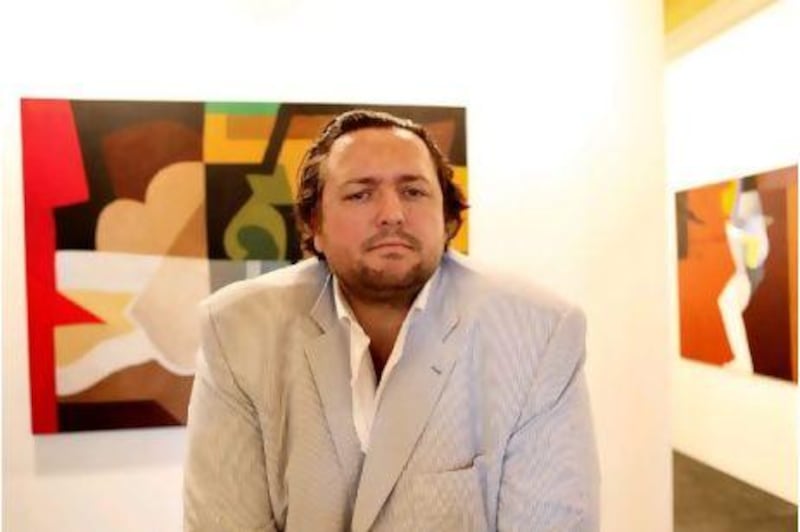I have many hats when it comes to Middle Eastern art.
As well as managing partner at Meem Gallery, I am a founder of Al Noor Institute of Middle Eastern Art, an adviser for the Abu Dhabi Music and Arts Foundation and a fellow of the Royal Asiatic Society.
I come from a family where art has always been appreciated. My great-great-great uncle, Sir Thomas Ferens, donated land and funds to build an art gallery in the city of Hull, in the UK, and later left it his fabulous art collection.
From a very young age, I was taught to appreciate art and I still believe art is best enjoyed for its own sake and not as an investment. The art market globally is not regulated and it is terribly manipulated. Millions of dollars are made as art is bought and sold.
Two of the world's biggest art houses have been found guilty of price fixing, but no one seems to care. So if you are looking at art as an investment, you should be very careful and do plenty of research.
The best art investments have proven to be Old Masters paintings and old manuscripts. They appreciate at about 8 per cent to 10 per cent a year.
I mixed with art professionals from a fairly young age. I went to Harrow School, where I was chairman of the History of Art Society. I organised lectures and liaised with directors of art museums to give lectures at the school.
From there, I went to the University of East Anglia and did a history of art degree.
After university, I became a marketing consultant; nothing to do with art. I got back into art professionally in about 2000, when I formed Art Advisory Associates.
In 2001, we landed a contract managing the art collection of Merrill Lynch Europe. At the time, one of my father's friends from Saudi Arabia got me interested in Islamic art. While working for Merrill Lynch, I met the art consultant Dale Egee, who was probably the greatest conduit in the rise of many Middle Eastern artists. When she retired, she offered me all her contacts on the understanding I would donate 10 per cent of all sales to the Medical Aid for Palestine charity. I promised to give 15 per cent.
From there, I began representing many Middle Eastern artists. Most artists are now living in European cities, but many of the buyers are from the Middle East region and I find myself spending more and more time in Dubai.
There is a lot of great art in the Middle East and a lot of this is still very undervalued. But about 80 per cent of the art market directly mirrors the fiscal movement of the property market, and we've seen how fickle that can be.
I would say 80 per cent of work in the UAE sold as having investment potential has proven to have zero investment potential. Up-and-coming artists touted as having the highest investment potential also have the highest loss potential. It's like investing in the dotcoms of the 1990s.
I think you should buy art because you love it. It doesn't matter how much or how little you pay for it as long as it uplifts you. Having said that, I paid for my wedding with the proceeds of a painting. I bought it for £800 (Dh4,745) and sold it two years later for £16,000.
It wasn't a painting I particularly liked. It was by a Syrian artist and Christies couldn't sell it. I said: "I'll take if off your hands for 800 quid and they said OK."
But it's very difficult to make a lot of money like this.
The art we deal with at Meem Gallery has been displayed in recognised museums and exhibitions. We don't have to hype up the artist; the proof is there.
If people really want to buy for investment, a good idea is to get a group of four or five people and buy works as a collective. Unlike investing in an art fund, this way you actually own the works.
I started buying art from a very young age. I was 16 when I began buying Hogarth prints and I bought my first antiquities at about 12. On holidays, I would buy bits of marble or stone I had been told was an original part of the Acropolis or some ancient site.
My father told me it was junk, but it didn't stop me. He encouraged me to haggle at the souqs. He told me whatever the price was, offer them a third and if they objected, walk off.
I always tell my clients there has to be a cut-off price. No matter how much you want a particular piece, you have to reach a point where you say "not today" and walk away.
I'm irresponsible financially, although I am more responsible now than I used to be. I have a two-and-a-half-year-old daughter, so I have to be. I'm not a great saver. Everything I earn, I spend on my family or I buy books or art.
Mostly when I buy art, it's because I love it. I sell maybe three or four pieces a year.
Most of my art is ancient Islamic or modern Middle Eastern. I bought a series of 8th century and 9th century Quranic manuscripts in 2004 for £15,000. It was about 15 pages; now each page is worth between £15,000 and £20,000.
But it is only worth what you can sell it for. With art you can't liquidate your assets quickly, but at least you can enjoy it.
If the whole world goes to pot, at least you can look a something beautiful and not be left staring at a share certificate in a frame.
* As told to Jane Williams






